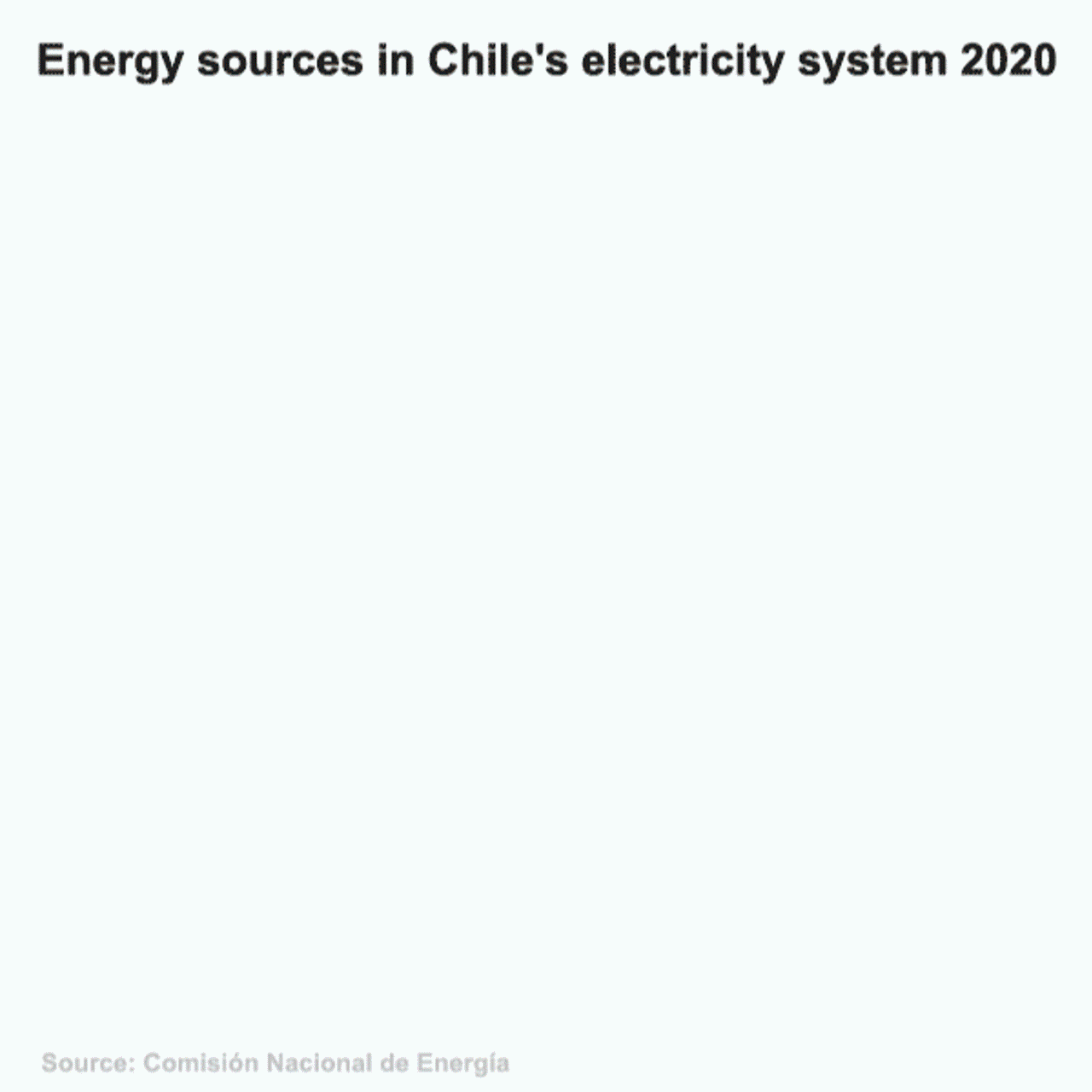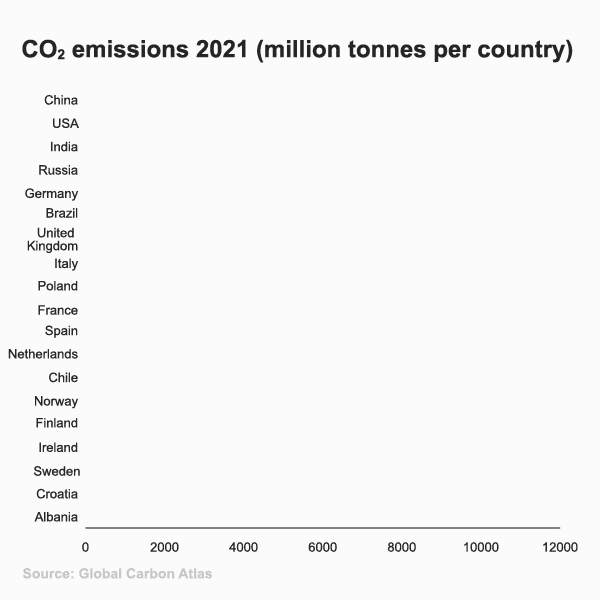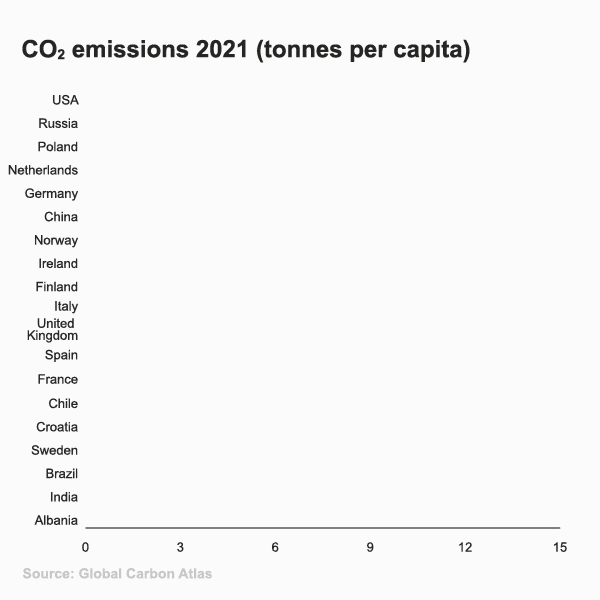
A well-suited place to produce solar energy is Atacama north of Chile. The desert lies in the rain shadow of the Andes and is considered the driest in the world.
Country series: Chile leads the way with commitment to renewable energy
Chile has ambitious climate targets: 70 per cent of the country's electricity will come from renewable sources by 2030, and the country will be carbon neutral by 2050.
Long and narrow, Chile is wedged between the Pacific Ocean and the Andes Mountains. It is the world's second-longest country from north to south, after Brazil, and spans 4 200 kilometres between Peru and Cape Horn. With its sun-baked deserts, windswept coastlines and cascading waterfalls, Chile has an abundance of natural resources that can provide clean energy. And it needs it: Chile is one of Latin America's fastest-growing economies, and its energy demand is rising accordingly.
Ever since the colonial era, commodity exports have formed the foundation of Chile's economy, with copper being the most important. Over time, wine, fruit, timber and fish have also become key export commodities. After 17 years of dictatorship, democracy was reinstated in 1990, and the country's subsequent positive economic development has led to Chile becoming the first South American member state to join the OECD in 2010.

Towards zero environmental impact
The effects of climate change are already being felt in Chile. Over the past ten years, the country has experienced a mega-drought, a record number of forest fires, melting glaciers and an increased incidence of extreme weather.
The country's government has announced a very ambitious goal: Chile will be the first developing country to achieve carbon neutrality by 2050.
"The goal is for Chile to absorb as much CO2 as it produces, so that by 2050 the environmental impact will be zero," explains María Teresa González, who is Statkraft's country manager in Chile.
The government has announced, among other things, that all Chile's 28 coal-fired power plants – which are mainly operated by companies from the United States, France and Italy – will close by 2040. The first phase involves closing eight thermoelectric plants.

Green commitment
Although coal is still the most important source of energy in the Chilean power system, renewable energy sources are playing an increasingly important role. In 2013, the authorities set a target of 20 per cent renewable energy in the country's electricity grid by 2025.
Latin America's first concentrated solar power plant, Cerro Dominador, is located in Antofagasta in the north of the country, with 210 MW of electricity, 17.7 hours of electricity storage and an investment of USD 1.4 billion.
A number of new hydropower, wind power and solar power plants are under construction in Chile.
The Chilean government has also promoted the introduction of electric buses in the public transport system and is encouraging alliances between bus operators, electricity companies and bus manufacturers using electric technology.

Rich in natural resources
In the Bloomberg report Climatescope 2020, Chile is ranked as the country with the best opportunities for developing renewable projects.
"The study was conducted in 108 new economies, and Chile and India topped the list, followed by Brazil, Jordan and China. The study highlighted Chile's implementation of government policy, investments and commitment to replacing coal in its power generation," says González.
"Electricity production in Chile is probably the sector where coal production is being reduced most rapidly, thanks to the ever-increasing and extensive use of renewable energy."
She adds that the key energy challenge facing Chile will undoubtedly be to meet the stated goal of phasing out all coal power in the national electric system by 2040. The country's power transmission system is another area that needs further development and upgrading.
With its rich natural resources, Chile still has vast potential to become the leading renewable power country in South America.

María Teresa González
María Teresa González is Statkraft's country manager in Chile.



Facts about Chile
-
Population: 19 million
-
Capital: Santiago
-
Government: Unitary presidential constitutional republic
-
President: Gabriel Boric
-
Language: Spanish
Chile's power generation
The energy sources in the Sistema Eléctrico Nacional (SEN) national electricity system and the national transmission grid had 56.3 per cent fossil origins such as coal and natural gas in 2021. The renewable share was 43.7 per cent and is increasing.
Chilean law defines clean power as "non-conventional renewable energy sources" (NCRE). In addition to coming from renewable resources, they must have minimal social and environmental impact. NCRE sources include biomass, hydroelectric power stations with a maximum installed capacity of 20 MW, wind power, solar power, wave power and geothermal power.
Source: Comisión Nacional de Energía
Statkraft in Chile
Statkraft has operated in Chile since 2004, and sees the country as an attractive market with a growing demand for renewable energy. In addition to hydropower, Statkraft has an important wind project in the centre of the country and is looking for new opportunities for wind and solar energy.
In Chile, Statkraft is involved in a joint venture with the Australian company Pacific Hydro (owned by one of the largest energy generation groups in China) to operate the La Higuera and La Confluencia hydropower plants. Between the regions of Los Ríos and Los Lagos, in southern Chile, Statkraft operates the Rucatayo hydroelectric plant, and construction of the Los Lagos hydroelectric project has begun.
Rucatayo and the Los Lagos and Osorno development projects are 100-per-cent owned by Statkraft after the company acquired a majority stake in the company Pilmaiquen in April 2015. More than 70 people work for Statkraft in Chile.
"Los Lagos hydropower plant is expected to be able to supply clean energy to the grid as early as 2022. The project, which represents a USD 173 million investment, is a positive sign for the local energy market," says María Teresa González, Statkraft's country manager in Chile.
Los Lagos will include a reservoir covering an area of 192 hectares.
"It's important to note that the area where the plant will be located is adjacent to 30 agro-industrial farms and will not affect indigenous lands," González emphasises.
Three wind farms
"In addition to hydropower, Statkraft is committed to adding more clean and renewable energy to the Chilean electricity system," González explains.
This includes three wind farms in in the central zone of the country: Cardonal (30 MW), Manantiales (27.6 MW) and Los Cerrillos (51.75 MW) in the O'Higgins region.
Growth strategy
In June 2018, Statkraft's Board of Directors decided to maintain the company's global growth strategy which focuses on increasing both installed capacity and markets.
"Statkraft will continue its growth strategy in Chile. The goal is to grow in scale and achieve a market share of 2.5 TW in the coming years. We want to triple the energy we generate over the next six years, with a strong focus on wind and solar energy," says González.
"Chile is a good country in which to invest, it has a robust regulatory framework and a mature and well-regulated market. Therefore, we are open to studying and evaluating any alternatives that emerge. We will have a special interest in initiatives to develop wind and solar energy, but will also promote our hydropower projects."

Other country series articles

Country series: German energy revolution
2017 marked the first year when more power was produced from renewable sources than from coal in the industrial giant Germany. Nuclear power and coal power will be phased out over the next few years,...
Read more

Country series: Sweden global leader in reducing climate impact
Few countries in the world use more energy per capita than Sweden. Nevertheless, its greenhouse gas emissions are low, thanks to renewables generating a large part of the power consumed. The homeland...
Read more

Country series: Albania's hydropower important for the Balkans
Albania can play a key role when the Balkan countries phase out fossil fuels in favour of renewables. Statkraft already operates in Albania, but political risk can put a damper on further growth.
Read more

Country series: Ireland with an ambitious climate action plan
About 40 per cent of Ireland's electricity currently comes from renewable sources, but the country aims to increase this to 70 per cent by 2030.
Read more

Country series: Green ambitions in Spain
Renewable sources accounted for almost 47 per cent of the electricity produced in Spain in 2021. This is the highest share of renewable electricity since measurements began, but short of the Spanish...
Read more

Country series: Resource wealth in Brazil
Brazil is blessed with a wealth of natural resources and one of the world's cleanest power supplies. Large-scale investment in solar and wind power will provide even more renewable power in the years...
Read more

Country series: Ireland with an ambitious climate action plan
About 40 per cent of Ireland's electricity currently comes from renewable sources, but the country aims to increase this to 70 per cent by 2030.
Read more

Country series: United Kingdom, a leader in ambition
The United Kingdom has major ambitions for cutting its greenhouse gas emissions. The goal is to become a zero-emission society by 2050. Getting there will be a taxing process and requires strong poli...
Read more

Country series: Faster progress on renewables in Italy?
With its long coastline, high mountains and sunny Mediterranean islands, Italy should be well placed to increase its production of renewable energy. The challenge is to link power production with co...
Read more

Country series: The United States is still a land of opportunity
Since Statkraft opened an office in the U.S. in 2015, the company's U.S. operations have revolved largely around trading in CO2 allowances and renewable energy certificates. Statkraft is now well posi...
Read more

Country series: Renewables grow fast in Poland
Poland is one of the largest countries in Europe both in terms of energy consumption and energy production, and coal is still the main energy source. At the same time, Poland has the fastest growing...
Read more

Country series: Green visions in France
Nuclear power nation France faces massive changes in the energy sector in the years to come. An ambitious commitment to wind and solar power is one of the measures that will ensure that the climate ...
Read more

Country series: Chile leads the way with commitment to renewable energy
Chile has ambitious climate targets: 70 per cent of the country's electricity will come from renewable sources by 2030, and the country will be carbon neutral by 2050.
Read more